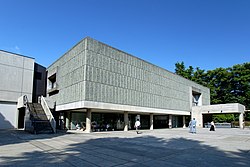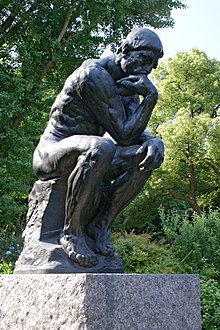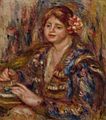National Museum of Western Art
 National Museum of Western Art, Corbusier Building |
|
| Data | |
|---|---|
| place | Taitō , Tokyo Prefecture , Japan |
| Art |
Art museum
|
| architect | Le Corbusier , Maekawa Kunio , Sakakura Junzō , Yoshizaka Takamasa |
| opening | April 1959 |
| management |
Akiko Mabuchi
|
| Website | |
The National Museum of Western Art ( Japanese 国立 西洋 美術館 , Kokuritsu seiyō bijutsukan , English The National Museum of Western Art , NMWA for short ) is an art museum in the Taitō district of Tokyo . It houses European and North American works of art from the Middle Ages to the 20th century and is the largest of its kind in Asia.
history
Japan's only state museum for Western art goes back to the art collection of Matsukata Kōjirō . Its collection, located in France, was confiscated as enemy property during the Second World War. In the late 1950s, France gave part of this collection to the Japanese people as a gesture of reconciliation. For the 196 paintings, 80 drawings, 26 prints and 63 sculptures, a new museum building was built in Ueno Park in Tokyo from 1957 . Since the opening of the museum, the museum's holdings have grown continuously and the original focus of the collection with French artists from the second half of the 19th century was supplemented by older works dating back to the Middle Ages and expanded by works from the 20th century. Today the collection comprises around 2000 works, which together with numerous temporary exhibitions represent a comprehensive overview of Western art history.
building
In 1957, the planning for the new museum building began under the direction of Le Corbusier . Together with Maekawa Kunio , Sakakura Junzō and Yoshizaka Takamasa , a building was developed that was designed for flexible growth opportunities from the start. In addition to the Matsukata collection, which was initially to be housed, the architects had also planned space for future acquisitions. The building, which was completed in 1959 after two years of construction, has a square floor plan. The concrete facades of the two-storey building are each loosened up by a panorama window, in front of which balconies with open stairs create connections to the surroundings of the Ueno Park. Inside there is a central atrium, from which a ramp leads to the gallery rooms on the first floor. Le Corbusier's pupil Maekawa Kunio designed the extension, completed in 1979, which, together with the main building, encloses an inner courtyard. Another extension from 1997 houses an auditorium and rooms for temporary exhibitions. At the same time, the existing buildings were renovated, which were reinforced against earthquakes on this occasion. Since 2016, the building is "as part of the World Heritage site The architectural work of Le Corbusier " in the list of UNESCO World Heritage listed.
collection
On the first floor of the main building, you can see works of European painting from the early 15th to the late 18th century. Italian painting is represented with Giorgio Vasari's Garden of Gethsemane , Paolo Veronese's The Marriage of Saint Catherine , Leandro Bassano's Last Judgment and Jacopo Tintoretto's Portrait of a Young Man as David as well as Giovanni Francesco Barbieri's David with the Head of Goliath or a Mater Dolorosa by Carlo Dolci . Other works in this section are a Lucretia by Guido Reni and a Madonna with Child and the Three Saints by Giovanni Domenico Tiepolo . The museum has the apotheosis of Admiral Vettor Pisani by Giovanni Battista Tiepolo and a portrait of a man by Pietro Longhi .
One of the artists of Flemish and Dutch painting is Joos van Cleve , who is represented in the museum with a triptych, the middle panel of which shows the crucifixion of Christ and the side panels depict the donor couple. By Bartholomeus Breenbergh is a coastal landscape and Herman van Swanevelt a view of Rome with Colosseum, Arch of Constantine and Temple of Venus seen. In addition, Joachim Beuckelaer Christ Carries the Cross , Anthonis van Dyck's portrait of Diego Felipe de Guzmán and Peter Paul Rubens ' Abundance and the depiction of two sleeping children . The museum also shows the still life Boy with Soap Bubbles by Gerard Dou , a village wedding by Jan Steen and various landscape views by Jacob van Ruysdael , Isaak van Ostade and Jan van Goyen .
While German painting is exemplified by Lucas Cranach the Elder 's Garden of Gethsemane , examples of Spanish painting are individual paintings by El Greco , Bartolomé Esteban Murillo and Jusepe de Ribera . The collection of paintings also shows by Joshua Reynolds , the portrait of Robert d'Arcy and Richard Wilson an Italian countryside as evidence of British painting.
The more extensive collection of works by French artists includes a Saint Thomas by Georges de La Tour , a Maria Magdalena by Philippe de Champaigne , the portrait of a young nobleman by Nicolas de Largillière , the rest of the soldiers by Jean-Baptiste Pater and the portrait of Madame Marie-Henriette-Berthelet de Pleuneuf by Jean-Marc Nattier . There are also landscapes by Claude Lorrain , Nicolas Lancret , Jean-Honoré Fragonard , Hubert Robert and Claude-Joseph Vernet .
The works of the 19th century and the modern age are located in the 1979 extension. The French painting of this period begins with works by Eugène Delacroix , Honoré Daumier and Jean-François Millet . The museum has a view of Naples by Jean-Baptiste Camille Corot and a still life with a carafe, flowers and fruit by Henri Fantin-Latour . Five works by Gustave Courbet can be seen in the museum, including a version of The Wave . The painting of French impressionism is a focus of the collection. In addition to a beach view of Trouville by the painter Eugène Boudin , the works Boy in Flowers and Portrait of Monsieur Brun by Édouard Manet are at the beginning of this collection area. In addition, the museum shows Pierre-Auguste Renoir , the images in the woods , Parisian in Algerian Costume and woman with hat , by Camille Pissarro a winter landscape , the harvest and the entertainment as well as Alfred Sisley a Landscape at Louveciennes . Due to the friendship of the collector Matsukata with the painter Claude Monet , this artist is most strongly represented with 16 works. In addition to numerous landscapes, two views of London are to be highlighted here. Smaller groups of works are also available by Paul Gauguin , Pierre Bonnard and Maurice Denis . The museum also owns individual paintings by Vincent van Gogh , Paul Cézanne , John Everett Millais , Emile Auguste Carolus-Duran , Giovanni Segantini , Dante Gabriel Rossetti , Gustave Moreau , Pierre Puvis de Chavannes and Paul Signac .
Significant names of 20th century artists, by whom the museum can show works in its exhibition, include Kees van Dongen , Georges Rouault , Maurice de Vlaminck and Chaim Soutine as well as André Derain and Max Ernst . Works by Fernand Léger , Joan Miró , Jean Dubuffet , Pablo Picasso and Jackson Pollock can also be seen.
The museum also has an extensive collection of drawings and prints. These include works by Dürer , Holbein , Rembrandt , Piranesi , Goya and Klinger .
Many of the museum-owned sculptures by Auguste Rodin can be seen on the ground floor of the main building . With 58 works, the museum has one of the best collections by this artist. Bronze casts of his famous works The Thinker , The Citizens of Calais and The Gate of Hell can also be seen in the sculpture garden .
Exhibited works
(Selection)
literature
- Seiro Mayekawa: Masterpieces Of The National Museum Of Western Art Tokyo . Tokyo 1983
Web links
- National Museum of Western Art (English, Japanese)
Individual evidence
- ^ UNESCO World Heritage Center: The Architectural Work of Le Corbusier, an Outstanding Contribution to the Modern Movement. Retrieved September 6, 2017 .
Coordinates: 35 ° 42 ′ 55.6 ″ N , 139 ° 46 ′ 33 ″ E










